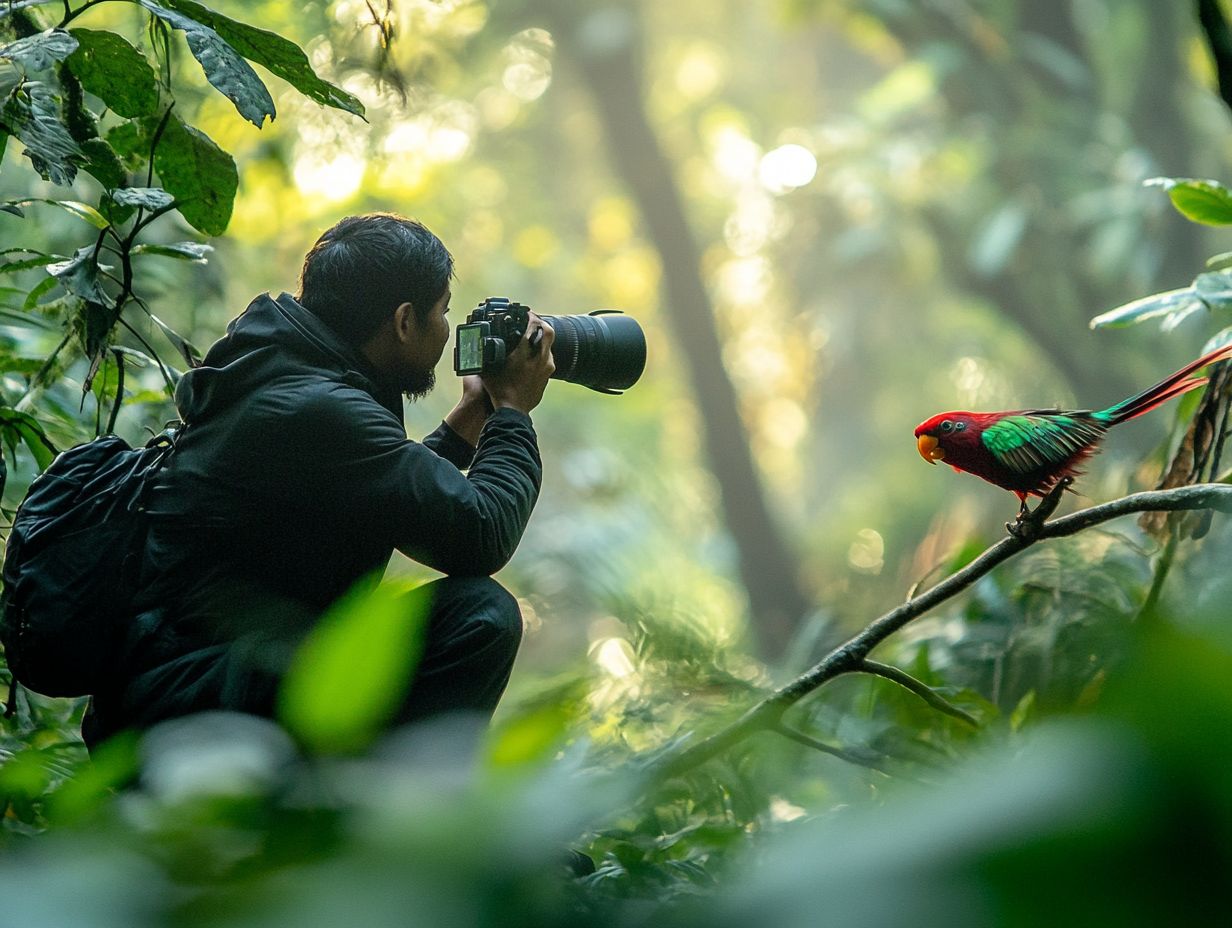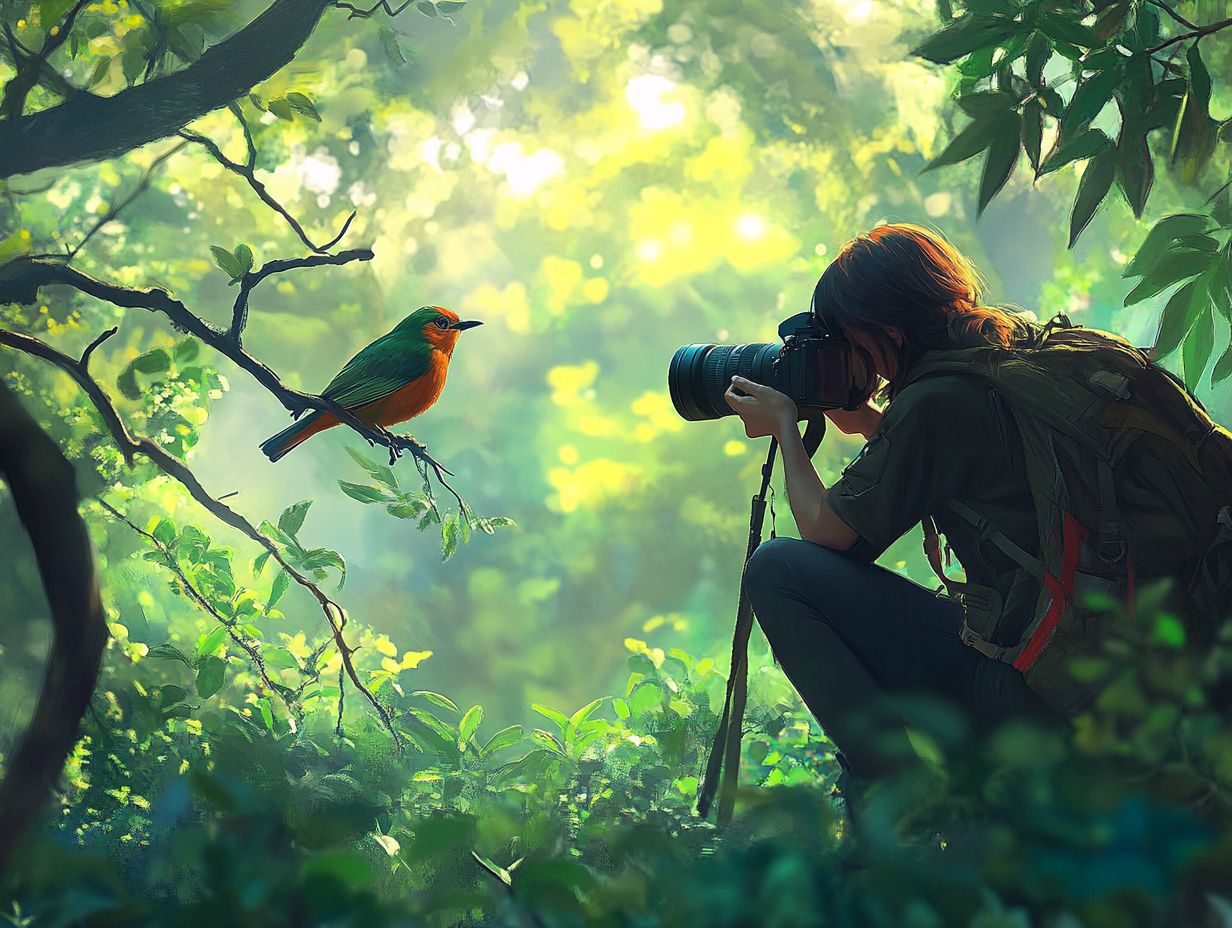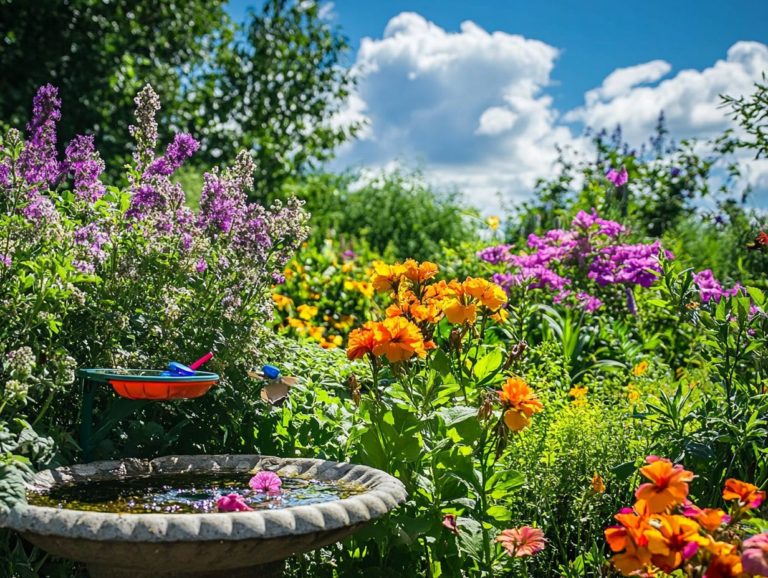What is Bird Watching Photography?
Bird watching photography combines taking photos of birds with respecting their homes. It allows you to capture the beauty of avian life in stunning detail through bird photography and bird videography.
Whether you re a novice or a seasoned photographer, this guide will provide you with essential gear, techniques, and insights needed to elevate your skills.
As you explore the benefits of this rewarding hobby and navigate its challenges, you ll discover how bird watching photography can enrich your life and deepen your connection with nature.
Are you ready to see the beauty of birds up close? Get ready to dive into the amazing world of bird watching photography!
Contents
- Key Takeaways:
- Equipment Needed for Bird Watching Photography
- Techniques for Capturing Great Photos
- Benefits of Bird Watching Photography
- Challenges and Solutions for Bird Watching Photography
- Frequently Asked Questions
- Curious About Bird Watching Photography?
- Why is Bird Watching Photography Popular?
- What Equipment Do I Need for Bird Watching Photography?
- Do I Need to Be an Expert in Both Bird Watching and Photography?
- What Are Some Tips for Taking Great Bird Watching Photos?
- Can Bird Watching Photography Have a Positive Impact on Conservation Efforts?
Key Takeaways:

- Bird watching photography captures images of birds in their natural habitats.
- Essential gear for beginners includes a camera with a telephoto lens (a lens that allows you to take close-up pictures from a distance) and a tripod. Experienced photographers may use advanced tools like camouflage gear and high-speed lenses.
- Techniques for great photos include finding and approaching birds without disturbing them and using composition and lighting techniques for visually stunning images.
What is Bird Watching Photography?
Bird watching photography is a captivating pursuit that combines taking photos of birds with respecting their habitats. This form of photography encourages you to deepen your understanding of bird behavior while honoring wildlife and promoting conservation awareness.
When using a telephoto lens to capture images of nesting birds from a distance or exploring bird videography, your main focus should always be the well-being of your subjects.
As you seek birds in their natural environments, adhering to ethical guidelines and minimizing disturbance is vital. Documenting these remarkable creatures enhances your appreciation for nature and plays a crucial role in raising awareness about the threats many bird species face.
Through your images and stories, you can inspire others to care for their environment and advocate for wildlife protection. The emotional rewards of bird watching photography are profound; those serene moments spent in the field cultivate mindfulness and foster a deeper connection with the world around you.
In this way, each photograph becomes more than just an image; it transforms into a compelling narrative that underscores the urgent need for conservation and respect for wildlife.
Equipment Needed for Bird Watching Photography
The right equipment is essential for enhancing your bird watching photography experience. A telephoto lens allows you to capture breathtaking images while ensuring the birds remain undisturbed.
Brands like Nikon, Canon, Sony, Olympus, and Fuji offer various options to cater to different skill levels and budgets. As a beginner, you may appreciate entry-level models, while seasoned photographers might prefer high-end lenses that guarantee exceptional clarity and sharpness, whether capturing moments in accredited zoos or natural settings.
Essential Gear for Beginners
For those of you embarking on the journey of bird-watching photography, investing in a quality long-range camera lens is absolutely essential for capturing crisp images while maintaining a respectful distance. Pairing a good lens with a solid understanding of shutter speed and composition tips can dramatically elevate the quality of your photos in natural light.
Grasping these foundational elements not only enhances your photographic experience but also helps you hone the necessary skills for observing wildlife.
A reliable long-range camera lens is not the only essential gear; a sturdy tripod can truly elevate your photography game! It’s also wise to have extra batteries and memory cards, ensuring that nothing stands in the way of capturing those fleeting moments.
Mastering shutter speed is crucial. Adjusting this setting allows you to freeze action or create mesmerizing motion blur. A solid grasp of composition techniques will lead you to striking images that effortlessly draw the viewer’s eye.
Effectively utilizing natural light can be the game-changer between an ordinary shot and a breathtaking one. Knowing when to shoot during those golden hours the times shortly after sunrise or before sunset when the light is soft and warm can significantly enhance the visual quality of your photographs.
With perseverance and the right gear, capturing the beauty of avian life becomes an incredibly rewarding endeavor.
Advanced Tools for Experienced Photographers
Experienced photographers engaged in bird-watching photography can elevate their craft by exploring advanced tools and techniques. Use flash sparingly to avoid disturbing the birds, and master the minimum distance guidelines to respect their behavior. This ensures you can capture stunning images without causing undue stress.
Photo editing software can enhance your images while preserving the integrity of the original scene. To elevate your skills further, consider incorporating high-quality lenses designed specifically for wildlife observation. These lenses offer improved clarity and sharper focus, allowing you to truly capture the essence of your subjects.
Using tripods or monopods will stabilize your equipment, making it easier to seize fleeting moments without disturbing the avian subjects.
Advanced tools like remote shutters enable you to snap pictures from a distance, minimizing your presence in their natural habitat. Employing these techniques thoughtfully can effectively showcase the beauty of avian behavior while honoring the wildlife you aim to photograph.
Techniques for Capturing Great Photos

Capturing stunning bird photographs demands more than just top-notch equipment; it requires mastering techniques that help you locate birds in their natural habitats and understanding the ideal settings for your shots.
A solid grasp of composition tips is essential for crafting visually captivating images. Harnessing natural light can significantly elevate the quality of your photographs when trying to find birds in their ideal settings.
By melding these techniques with patience and consistent practice, you can achieve truly remarkable results.
Tips for Finding and Approaching Birds
When you’re on the hunt for birds, the secret lies in avoiding disturbance while maintaining a respectful distance. This not only ensures the safety and comfort of the wildlife but also provides you with prime opportunities to capture breathtaking images. Plus, it cultivates a sense of conservation awareness that s essential for every photographer.
By taking the time to understand bird behavior, you can significantly enrich your experience and improve your photographic outcomes. Dive into their feeding habits and nesting patterns, and you’ll enhance your chances of observing and photographing these creatures in their natural settings.
Remember to stay silent and patient, moving slowly to avoid startling them. Using natural cover, such as trees and bushes, can help you get closer without causing any stress to the birds.
If you re aiming for high-quality photographs, investing in a long-range camera lens will allow you to take striking shots from a distance, minimizing disruptions. Also, consider the time of day; early mornings often bring heightened bird activity, leading to more encounters and a deeper connection with wildlife.
So, are you ready to grab your gear and head out to capture the beauty of avian life? The adventure awaits!
Composition and Lighting Techniques
Effective composition and lighting techniques are essential for capturing the true essence of bird photography. By mastering composition tips, you can turn your ordinary photos into amazing ones that are both engaging and aesthetically pleasing. Using natural light adds depth and dimension to your shots. A keen understanding of shutter speed allows you to freeze fleeting moments of avian action. When combined with thoughtful photo editing, these elements can elevate your images.
Focusing on the rule of thirds helps you position your subjects dynamically, enhancing overall interest in the frame. Mindfulness of your backgrounds especially when shooting against a beautifully blurred backdrop makes your subject stand out. The early morning or late afternoon light, often referred to as the golden hour, casts a warm glow that beautifully flatters your feathered friends.
Adjusting your shutter speed to align with the bird’s motion is crucial. A fast shutter speed captures a hovering hummingbird, while a slower setting beautifully conveys the grace of a perched eagle. This provides insight into both the bird s behavior and its environment, which is vital for conservation awareness.
Benefits of Bird Watching Photography
Dive into the exciting world of bird watching photography to unlock incredible benefits! It boosts your physical health through invigorating outdoor activities and enhances your mental well-being by cultivating mindfulness and a deeper connection with nature.
Participating in this enriching practice deepens your appreciation for bird behavior and heightens your awareness of conservation. This fosters a greater respect for wildlife and their habitats.
Whether wandering through local parks or venturing to famous birding hotspots, the positive effects of bird photography go far beyond the art itself.
Physical and Mental Health Benefits
The physical health benefits of birdwatching photography are significant. As you traverse various terrains, your activity levels naturally increase. This pursuit engages your body and nurtures your mind. Immersing yourself in nature fosters mindfulness and offers a refreshing escape from daily stressors, making bird photography a rewarding endeavor for both body and spirit.
Engaging in activities like hiking, climbing, and kayaking allows you to explore diverse ecosystems. These varied environments enhance your physical stamina while deepening your appreciation for the biodiversity around you.
The intense focus needed during a photography expedition cultivates a sense of presence that effectively combats anxiety and sparks creativity. By attuning yourself to the gentle chirps of birds and the rustling leaves, you re likely to find your stress levels diminishing and your emotional well-being improving. These moments spent outdoors create a profound connection with the natural world, enriching your overall experience.
Conservation and Education Impact

Bird watching photography is more than just a hobby; it s a powerful tool for conservation and education. As you capture the beauty of birds and their behaviors, you become an advocate for wildlife preservation. Your artistry raises awareness about critical conservation issues and inspires initiatives that protect avian habitats.
Consider the Audubon Society, which often employs stunning bird photography to engage the public and bolster their conservation campaigns. Through workshops and exhibitions, they create connections among photographers and enthusiasts, cultivating a community dedicated to safeguarding fragile ecosystems.
In schools, educational programs harness captivating imagery to teach students about biodiversity, nurturing a new generation of conservationists. When you share a striking image of a threatened species online, you could spark grassroots movements, generate funding for habitat restoration, and even drive essential policy changes.
Join the movement! Grab your camera and start capturing the beauty of birds today! Your artistic lens becomes not just a medium of expression, but a vital catalyst for environmental stewardship.
Challenges and Solutions for Bird Watching Photography
Birdwatching photography presents its fair share of challenges. One such challenge is changing weather, which can thwart your efforts to capture that perfect shot. Always be aware of ethical considerations, especially the safe distance you should keep from birds to respect their behavior.
Overcoming these hurdles demands your creativity, adaptability, and a commitment to responsible practices.
Weather Challenges in Bird Watching Photography
Dealing with weather obstacles in birdwatching photography calls for a blend of preparation and flexibility. Different weather conditions can dramatically influence your shooting opportunities. By understanding the ideal settings for various scenarios and ensuring your equipment is well cared for, you can maximize your chances of capturing breathtaking images, even when the elements pose challenges.
It’s crucial to study how lighting, background, and bird behavior adapt to shifting weather patterns. For example, overcast skies can offer a soft glow that’s perfect for showcasing vibrant feather details, while bright sunny days might require lens filters to cut down on glare. Don’t forget to consider how wind can affect both the stability of the birds and your own shooting posture.
Equipping yourself with essentials like tripods, lens hoods, and waterproof bags not only protects your gear but also enhances your chances of success. By anticipating these factors, you’ll be ready to adapt quickly and seize the moment when birds are most active, transforming the unpredictable nature of weather into a mere backdrop for your stunning wildlife shots.
Why Ethics Matter in Bird Photography
Ethical considerations in bird photography are of utmost importance. Always be aware of your impact on wildlife and adhere to strict guidelines regarding minimum distance and disturbance. Practicing ethical bird photography not only safeguards the integrity of your subjects but also cultivates conservation awareness within the wider community.
By prioritizing respect for the natural behaviors and habitats of avian species, you can significantly contribute to their preservation. For example, maintaining a safe distance is essential to ensure that birds aren t stressed or driven away from their nests especially critical during breeding seasons.
Using gear that minimizes noise and vibration will help you capture stunning images without causing disruption. By adhering to local wildlife regulations and being mindful of seasonal restrictions, you ll foster a deeper appreciation for the environments where these birds thrive, inspiring others to become stewards of the natural world as well.
Frequently Asked Questions
Curious About Bird Watching Photography?

Bird watching photography is the practice of capturing images of birds in their natural habitats. For those new to this rewarding hobby, understanding what bird watching is and how to start can help you combine the activities of bird watching and photography to create stunning images of birds in the wild.
Why is Bird Watching Photography Popular?
Bird watching photography has gained popularity due to the increasing interest in nature and wildlife conservation. It allows people to appreciate the beauty of birds and their role in the ecosystem while also capturing their unique behaviors and characteristics.
What Equipment Do I Need for Bird Watching Photography?
To get started with bird watching photography, you will need a camera with a telephoto lens, a tripod, and possibly a pair of binoculars. It is also helpful to have a good understanding of your camera’s settings and basic photography techniques.
Do I Need to Be an Expert in Both Bird Watching and Photography?
No, you do not need to be an expert in both bird watching and photography to enjoy bird watching photography. However, having some knowledge and skills in both areas will greatly enhance your experience and results.
What Are Some Tips for Taking Great Bird Watching Photos?
Some tips for taking great bird watching photos include learning about the behaviors and habitats of birds, finding the right lighting and composition for your shots, and practicing patience and observation in the field.
Can Bird Watching Photography Have a Positive Impact on Conservation Efforts?
Yes, birdwatching photography can greatly help conservation efforts. Taking and sharing photos of birds in their natural habitats raises awareness and appreciation.
This appreciation can lead to real actions to protect these creatures and their environments. Join the movement and help make a difference!






